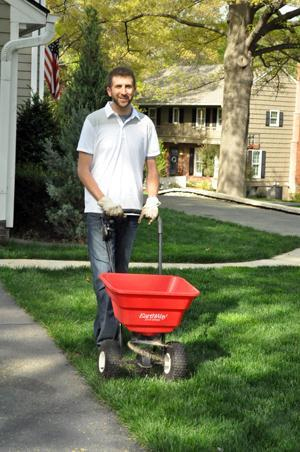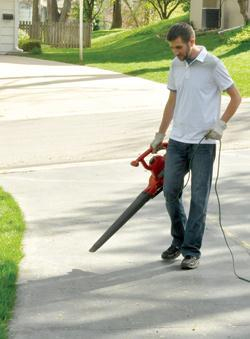Healthy Yard and Environment Tip: September
Restoring Your Lawn
Fertilizer — right time, right place. Cool season lawns are best fertilized in September and November for strong, healthy growth. Be sure to sweep fertilizer off paved surfaces to prevent them from entering the stormwater drains.

Apply fertilizer at the right time
Fall is the best time to fertilize cool-season lawns like tall fescue and bluegrass.
Step one: Get a soil test
The first step is to get your soil tested. Testing your soil will insure you are fertilizing appropriately. K-State Research and Extension provides soil testing services to residents for a minimal charge.
Click here for instructions on how to take a soil test.
A basic soil test provides homeowners with the necessary information to begin a fertilization schedule. The results of a soil test will answer four questions:
- What nutrients does my soil need?
- What type of fertilizer should I use?
- How much fertilizer should I use?
- How often should I fertilize?
Soil tests take the guesswork out of buying fertilizers and help homeowners to avoid using too much fertilizer — which can be an unnecessary expense and an environmental hazard.
Why is soil testing important?
Common fertilizers contain the nutrients nitrogen, phosphorous and potassium. When used properly, these nutrients are essential to healthy lawn and garden maintenance. Over-application of fertilizers can be harmful to your lawn and garden, as well as local waterways.
When rainwater flows off rooftops to lawns, driveways and streets, it picks up pollutants such as fertilizers along the way. Stormdrains then take the polluted water to nearby lakes and streams — UNTREATED.
Step two: Keep fertilizer in the right place
- When using a fertilizer with a high percentage of nitrogen in the water soluble form, do not apply if a heavy rainfall is expected.

- Apply about a half-inch of water after a fertilizer application to move the fertilizer into the topsoil,
- Sweep fertilizer and pesticide residue back onto the lawn where it is most likely to be utilized by the grass.
- Use a drop spreader rather than a rotary type spreader when applying fertilizer near open water.
- Make sure you shut off the spreader when passing over pavement.
- Clean up any granular spills and spread the material according to label directions.
- Fill spreaders over hard surfaces for easy cleanup.
- Push the fertilizer spreader, do not pull. Start walking before opening the lever and close the lever before stopping. Do not spread while turning. Keep the fertilizer dry so that it flows evenly from the spreader.
- When using the spreader, walk in straight lines using reference points such as the spreader wheel marks or footprints to avoid overlapping streaks.
- Do not apply fertilizer immediately before an intense rain storm.
- Do not dump or wash off excess fertilizer into storm drains or sewers.
- Fertilize when grass is dry to allow fertilizer to sift down into the soil.
Return to Healthy Yards and Environment
- Kansas Healthy Yards and Communities
- Kansas Healthy Yards Self-Assessment (Find out how you are doing in your landscape)
- Kansas Healthy Yards Videos
Maintaining a Healthy Yard and Environment
Here are some specific tips you can follow each month to make sure your yard is a healthy yard and environment.